This site contains affiliate links. Please see Policies for more information.
Looking for more blogging tips? Everything But the Posts, my new book, gives tips about setting up a blog, connecting with your community, and monetizing. It’s available in paperback, on Kindle, Nook, and iBooks.
___________
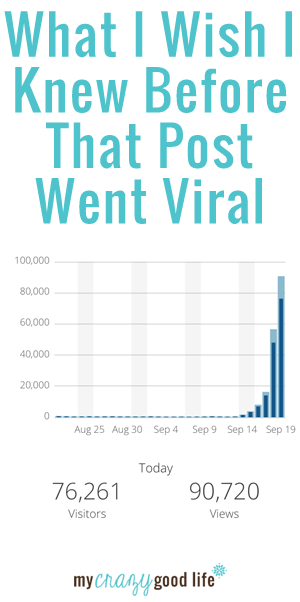
A little over a month ago, one of my blog posts went viral.
It was my post Apple iOS7 Tips & Tricks, published 6 days before the operating system was released to the public. It was based on my experiences as a beta tester.
My previous definition of a viral post was “any post that receives five times your average views in a week.” Because we all have those posts that catch some steam and spread like wildfire, and that’s awesome.
But this was different.
This post was viral.
That single post received 90,720 views in one day.
947,863 views to date.
It brought me the highest day of traffic for My Crazy Good Life, at 160,384 pageviews.
It crashed my blog and put me in hot water with my host.
It cost me a lot of money, and made me miss quite a few deadlines.
And that post spread to other posts within my blog, thanks to interlinks. In just over one month, my little blog had received over one million pageviews.
Boy, have I learned a lot in the past six weeks. And I’m sharing.
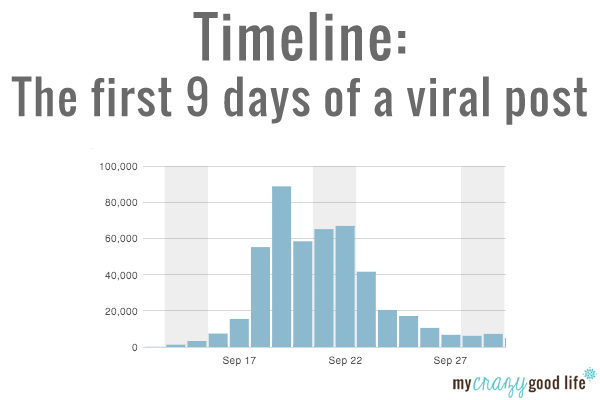
Here’s the timeline of the first 9 days the post was published:

Day 1. Published iOS 7 Tips & Tricks on a Friday afternoon after Karen noticed that my guest post on her blog (iPhone 101 Tips & Tricks) was getting a lot of traffic. I pinned it a few times and shared once on Twitter and Facebook.

Day 2. I noticed the post being pinned–a lot. Within 24 hours of being posted, the iOS 7 post was pinned about 2,000 times.

Day 3. Noticing my previous “record high day” of 2,200 pageviews being blown out of the water, I called my host. I’d heard too many bloggers talk about how they got so much traffic that their host shut them down. That wasn’t going to happen to this girl.
Me: So, I have this post that’s going viral. What do I have to do to my account to make sure it won’t be shut down?
Host Gator: Nothing! You’re good – you have unlimited bandwidth, so congrats and enjoy this!
Me: Well, I’m thinking it’s not that easy. You see, I’m at 2,500 views today and we still have three days until the operating system hits, so I’m thinking this is going to be pretty big. Like, tens of thousands of views probably on Wednesday.
Host Gator: I know! Seriously, you’re good – unlimited bandwidth. Don’t stress.
Me: You’re sure? I’m only paying $15/month for hosting. That doesn’t sound very unlimited to me.
Host Gator: You’re in good hands. Don’t stress.

Day 4. I sat, waiting and watching. And watching. I put an ad on the post and signed up for a Google dfp account. I also asked a few of my facebook boost groups to share the post for me, making sure I was getting the maximum amount of eyes on it.
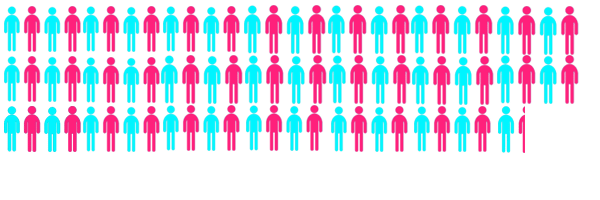
Day 5. The day before the release date of iOS7, and I noticed my blog was a little slow. As I was heading to bed at 10pm I checked my email and there it was: a warning from Host Gator.
I had exceeded my bandwidth and unless I found a way to fix it, they were shutting me down. Their email chain said a few things: disable SEO by Yoast, as it causes excessive loading; enable a super cache; move the post receiving all the traffic to its own static page; disable the search feature on my blog.
I did the things I could, and received another warning about 15 minutes later.
I called them. This was exactly what I didn’t want to happen.
I was put in touch with the rudest customer service rep I’d ever spoken with. I had loved Host Gator up until this point.
I explained that I tried to avoid this by calling Sunday, why wasn’t this mentioned? I had unlimited bandwidth, right?!
Host Gator: Ma’am, UNLIMITED does NOT MEAN INFINITE.
Me: Well, ummm, yes. Actually, it does.
Host Gator: Well, not in terms of bandwidth.
Me: Oh, I must have misunderstood that from our conversation Sunday. Maybe I didn’t ask for enough clarification?

Day 6. The way this works is, you receive a warning that your host has blocked your account. You can choose to lift that block 5 times before it’s permanent.
At this point, Host Gator claimed they could do nothing for me. They couldn’t give me more bandwidth, they couldn’t congratulate me on the traffic and turn their heads to let my blog ride this out, even though my bandwidth usage before this post didn’t ever come close to what I actually paid for.
They couldn’t transfer me to a dedicated server without taking my blog down for 3-5 days.
Today was the release of the new Apple operating system.
My post had been pinned 118,300 times.
My pageviews had been doubling every day since the article posted.
And I was going to be shut down.
I emailed the person who takes care of my technical blog stuff. She listened to me swear. She swore with me. She shook her head when she heard what happened and she told me how to fix it.
I had to change hosting companies.
A Small Orange was recommended to me, and after emailing back and forth a bit (they’re quick and responsive) we had a plan.

Day 7. After a few heated phone calls, Host Gator logged into my WordPress blog, changed the password on me, and kicked me out.
They installed a cache plugin of their choosing, but didn’t activate it.
In addition, they disabled the cache plugin that had previously been activated.
Essentially, they broke their own rules (they said I had to have a cache plugin) and caused my CPU usage to skyrocket, which shut my blog down.
I was the girl. I was the blogger who was on the phone crying to a total stranger and attempting to keep her cool.
I was livid.
That night, my blog helper switched my accounts to a cloud server with A Small Orange. She worked in the middle of the night to avoid the peak traffic hours.
After a series of long outages all day long, Host Gator shut me down at 7pm, which was the start of my peak traffic time, 7pm-11pm.

Day 8. I woke up with A Small Orange. They were helpful and quick to respond to all of my questions. I knew more about caching and bandwidth and CPU usage than I ever needed to know at this point.
After noticing my views were slowing down a bit, the Ninjas at A Small Orange (that’s what they call themselves, it’s in their email signatures) helped me install a cache program into my server and showed me where to keep an eye on my views.
I just went from paying $15/month for hosting to $100/month. I also hired my someone to switch my three sites to A Small Orange and set up my ad network accounts.
Having a viral post is expensive.

Day 9. I had no idea that a viral post could bring you traffic for such a long time. I guess in my head it was a 1-2 day thing. I was 9 days after the post and still seeing tens of thousands of views. The traffic was pouring in from Pinterest at this point.
Total views on the viral post as of 10/30: 534,700
Total pins as of 10/30: 155,000
Here’s what I learned:
Things you have control over:
- Your analytics. You can check them regularly and monitor your traffic, which I highly recommend.
- Your hosting package: switch to a dedicated server as soon as you see a post getting big like that. If I had switched (using my blog helper, not what Host Gator was offering to do) that Sunday when I called to ask Host Gator about my account, I would have been moved to the new server by the time the operating system was released, and wouldn’t have lost those 12 hours of traffic (and ad money!).
- Ads on your blog. You don’t have to put them on every post or on your sidebar, but apply to networks and add them to individual posts that are doing well. The main reason? You’ll be able to quickly ad more of them to your blog when you have a viral post. I had to wait to be approved to different ad networks after this happened, which ended up costing me money.
- SEO. SEO your posts. 80% of my viral traffic came from Pinterest. The other 20% came from searches. To this day, 6 weeks later, 9/10 searches on my blog are for iOS7 issues.
- A great tech guru. Having someone “in my back pocket” during this crazy time was a lifesaver. She offered advice and knows a heck of a lot more about all this than I do. She was there when I needed her and quickly to offer her help at (literally) all hours. She understood what was going on and how important it was to me.
Things you have no control over:
- The speed at which your post travels. Don’t stress about being shut down if it’s going to happen–you can’t do a thing about it. You can’t stop people from clicking on or sharing your post.
- Your blog up-time or downtime. I had to contact a few people and ask for grace when my blog was unstable. I was told that writing posts, checking plugins and other “back end issues” would affect the way the front of the blog was
crashingperforming, so I should stay out. I had three sponsored posts that missed their deadlines, which stressed me out more than anything. But, there was nothing at all that I could do about it at that time except apologize and ask for an extension on my deadlines.
What I wish I knew then:
I wish I had listened to the quiet whispers in the blogging community and moved to a blogger-friendly host. Not only for instances like this (which I understand don’t happen often at all), but to support smaller hosting companies who understand the importance of blog up-time. A Small Orange responds quickly to my inquiries, is patient with explaining all of the confusing back end blog information that I don’t understand and more than anything, they are kind and respectful. If you’re turning your blog into a career, a blogger-friendly hosting company is a non-negotiable.
For 99% of hosting companies, bandwidth is limited, even if they advertise that it’s unlimited. Be aware of that.
What I’m doing different now:
I’m using Google dfp for my ads. It has doubled my ad income, which makes a huge difference. I’m also a bit more tied to my analytics, which I’m embarrassed to admit. Maybe once my traffic returns to normal, I’ll break away from checking and documenting my numbers so much.
My popular posts now have a place on my sidebar, for easy access from any page within my blog.
Adding a line at the top of my posts with a link for my email subscription. I’ve seen a 200% increase in my subscribers since doing that for all of my popular posts.
Bottom line: I followed my own rules for making a post go viral, and after several smaller *viral* posts, I hit it big. I’m reluctant to take credit for it, as it’s not something that can be replicated. I do, however, know that through creating pinnable images, using SEO, creating web-friendly content that was relevant to current trends and being a step ahead of most tech blogs, I did play a part in the success of this post.
After all was said and done, I made a few dollars. I lost a lot of time. And my pageviews have increased substantially (even after taking the viral post out of the mix).
And I’m pretty excited about that.

My viral post still receives between 200-600 hits a day. Still a lot of Pinterest traffic, but a lot of search traffic as well. I have been able to reduce my hosting plan to a $50/month one, but my overall traffic still isn’t anywhere near what it was last year at this time. I credit the viral post and a lot of linking out to other posts for the subscribers and readers I’ve gained.

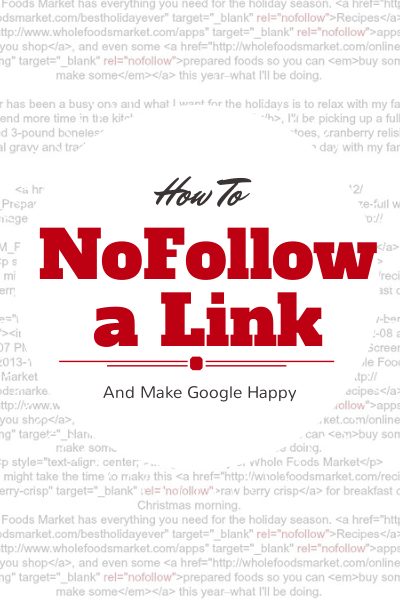
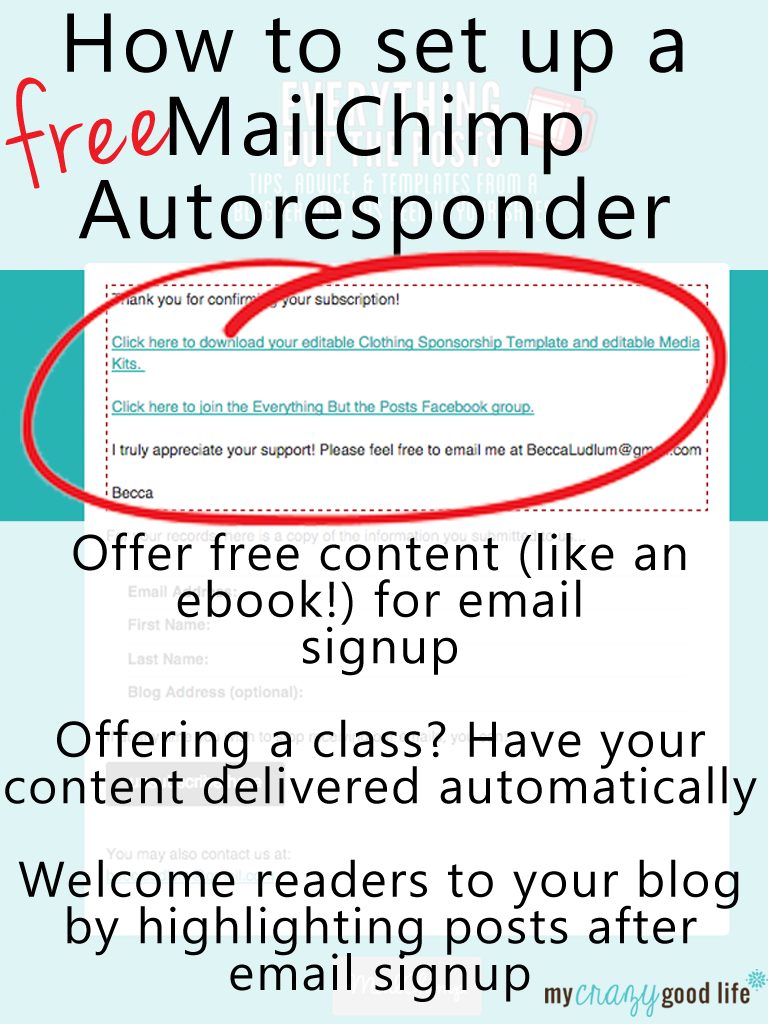

































Hi,
I wanted to add to your conversation here. EIG Insurance owns both HG and ASO. So I would still make sure you have money on hand to transfer again. We as a design Company went with Liquid Web where I can scale the server if I get a high load.
Otherwise, very well written and good advice!
Thanks, Jonah. I’m confident that though owned by the same parent company, A Small Orange has much different expectations as a company than Host Gator does.
Really usefull! I’m going to try dfp and see what happens.
Thanks for sharing.
Good luck with dfp!
I had HostGator once. It only took once before I realized what they were really like. .-. It’s sad you had to learn the hard way, though.
My host is pretty awesome; they’re much cheaper than the $100/mo. you’re paying. o.O ASO is kind of a smaller hosting site, though. Anytime a host says anything is unlimited, you should be wary of your resources. When your website begins to use more resources on the server than other sites is when it becomes a problem. The servers hosts use also make a big impact on the amount of activity your website will be able to withstand.
Good luck in the future! :)
Cloudflare can save tons of bandwidth. It caches static content and serves it up from their own content servers. I pay $40 per year for a vps with 2gb of ram, 2gb of swap, 4 cores, and 3tb of transfer. I know vps isn’t a good approach for many, but it works for me, and is dirt cheap.
I may not have any “viral” posts yet, but if I ever do, I’m ready for it!
I’ve heard a lot about Cloudfare, Mike, and have been cautioned against using it. I am looking into it further on my own now, as it kind of seems like a no-brainer to me. Thanks for the tip :)
I’m small-fries…but I’m still going to try to add to your traffic. I’ve yet to read your iOS7 tips & tricks, but this post was one of the best posts of blogging issues I’ve ever read. THANK YOU!!
You’re the best, Aaron – thank you!
$11+ per hour is a nice little bit of pocket change for this learning experience. I hope it continues to grow for you since the post will undoubtedly keep getting good traffic. This was a really interesting story from behind the scenes. Thanks for sharing your experience.
Absolutely! Definitely worth the experience, Kim!
I’m so grateful for posts like this one. Thank you for sharing your experience with other bloggers.
Thank you for stopping by, Laura!
I really enjoyed reading this breakdown of what happens behind the scenes!
I’ve had a few instances where my host wasn’t able to keep up with the demand of my sites, and I’m currently looking for a new host to get ready for 2014. I have a lot planned (whether it goes viral or not doesn’t much matter, I just hate having downtime on my site during launches) and I want to make sure not to lose sleep over it!
Thanks for recommending A Small Orange and for sharing your candid experience!
It’s scary to think this might happen to me but I’m so thankful you shared your experience to help others! Pinning this now and thinking about changing some things on my blog!
Great post!
I have a very minimal website just to hold the account under my name and possibly start a blog with. My contract with the hosting company expires at the end of the year and I’ve had nothing but trouble with the hosting service. Thanks to your recommendation, I’ll be switching to A Small Orange. All the best!
Zane
Thank you, Zane!
Sadly, every provider in the shared hosting world does that. Sorry you ran into it. My mother in law had the same thing happen. Such is life.
I’m an independent guy who has worked closely with some of the above mentioned providers as a consultant/architect/developer/whatever. The above companies are extremely talented at doing very specific things – running reliable hosting environments, doing so with limited resources, and keeping costs low for end users. But once they get into situations like high volumes of traffic for a single client, it’s the moon to them.
My specialty is running extremely high performance web environments – upwards of 10 million requests per hour, on very small servers – think $25 per month per server (with several around the world for redundancy), plus several thousand for bandwidth.
A couple things:
1 – What you already know. You’re totally right – bandwidth is expensive. Even if you’re not running the CPU really high (ie, if you ran your own Memcache + Batcache setup like wordpress.com), bandwidth still costs a lot – something like $0.15 per GB. So your page has about 1MB of content – so every thousand page views costs about $0.15 in pure traffic. So a hundred thousand page views would be around $15 in bandwidth alone. That’s about the point at which you’ll get bandwidth-throttled even if you’re running very little CPU. Just using a CDN like Cloudfront would take care of 99% of this, but it basically just shifts the costs to you a little more directly.
2 – What you probably don’t know. Typically, you only need a really high end hosting environment if your caching setup is either (a) totally jacked – which is pretty much standard for anything you can install yourself; or (b) you’re not caching and have a fairly small level of traffic (around 10k visits per CPU per day). With a decent caching setup (no CDN), it’s possible to handle around 10k views per second, on a single CPU.
So, that said, there are several ways to do caching and CDN well; they scale directly with your level of traffic, and don’t require you to switch to a super expensive dedicated environment. The major thing with caching is to ensure that the cached content isn’t served by PHP – because starting up PHP is by far the most expensive step in generating a page. You want something that’s keeping a copy of your pages in memory and serving them right at the point where the end-user’s computer is requesting the page. If it’s hitting the disk at all, a server is typically limited to serving 20 cached pages or scripts or stylesheets per second (assuming you don’t have a pile of extra RAM sitting around)… So that’s a big reason why your site still takes so long to load, even on a dedicated server – even with the caching plugin, it’s still hitting both PHP and making the hard disk look around for stuff.
The obvious and quick solution is Cloudflare, and it’s unfortunate you didn’t find this out during your sage. You point your frontend domain at their servers, and they run a pretty efficient geographically distributed caching thing for your site, which still runs on the same shared-hosting environment. So basically, Cloudflare takes all the load + bandwidth off of your own hosting environment (which can be basically as cheap as you desire), and you pay for bandwidth that’s actually used by people who are visiting your site. Sometimes you run into issues with new content not showing up instantly, but it usually resolves itself a few minutes later.
The other options are similar environments in which they are using a similar caching/distribution technology but also serve as your hosting company. This works pretty well, and you have a single point of contact to help (or blame) if you have any issues. You do have to switch hosting providers, but typically they’re good about helping you through the process. I’m a fan of this methodology because you have a little more control of everything going on, and if you have to edit things manually (which is all I really do), you don’t have to wait for cache purges to clear around the world. Pagely (http://www.page.ly) is a great example of this.
So… The moral of the story of is: Use an environment that sells by bandwidth and uses a smarter caching solution – any of the normal WordPress caching plugins really only buy you a factor of two or three difference because they still require a lot of overhead in terms of having the wrong web server, storing data on hard disk, or running PHP when it’s not needed. A dedicated server is totally unnecessary unless you have a pretty specific set of circumstances that require it.
So that’s all. If you have any questions I’d be glad to answer – if I don’t respond right away, I’m just trying to keep up with the queue.
Wow, Israel – thank you for all the information! Give me a few days to digest this – it’s still so new to me!
I just set up Cloudflare and it was a piece of cake! Definitely the easiest solution for someone like me. So glad someone sent me the link to this post.
That exact same thing happened to me! HostGastor totally screwed me, and I’ll never give them another dime. But why would I? ‘Cause A Small Orange is AWESOME! I’ve never been happier with a host before.
Congrats on the viral post!!! :-)
Great post. No viral stuff for me just yet, but has really opened my eyes to future considerations.
Thanks for sharing!
Thank you for telling this story! Amazing how there are always these similar situations happening across many wordpress blogs! We don’t have to face it alone, we could all use shared help collectively. Thanks for putting it to words!
-Claire
http://www.clairefromyvr.com
Congrats on the viral post, but WOW I had no idea that I even had to worry about bandwidth!! Thanks for the tips!
I didn’t either, Stephanie, but it’s REALLY important!
So many lessons to be heeded! Noted and moving forward! COME ON, VIRAL POST!
Crossing my fingers for you, Patti!
Great post! I am far from having a viral post, but definitely an eye-opener! Didn’t know you could be shut down b/c of too many people reading your post! Wow!
Pinned for the future!
You can! It’s nuts, but I understand where they’re coming from.
And you never know how far away you are from a viral post… I never would have guessed it would have happened to me!
Holla! Love this! And love that this post is also going viral!!!
Unfortunately, unless/until we do have a post go viral, most of us can’t afford $100/month hosting. :( So we’ll pretty much all end up in that boat at one point or another if we ever get that big. :P
I just loved how honest and real this post was. Thank you. I don’t expect to ever have a viral post like this. In spite of all the headache, I am super happy for you. I even pinned that post to my boards, not even knowing it was yours :)